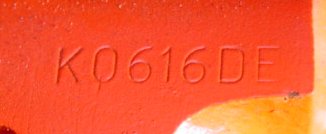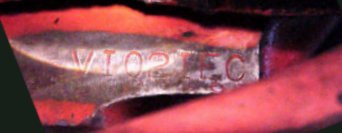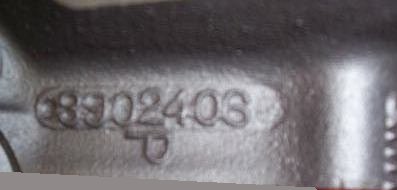Engine ID Suffix Codes
|
Engine |
Transmission |
Notes |
|||
| Code | Size | HP | |||
| BB | 230-1 | 140 | Manual-3 | Heavy Duty Clutch/A.C. | |
| BC | 230-1 | 140 | Manual-3 | Heavy Duty Clutch | |
| BL | 230-1 | 140 | Powerglide | A.I.R. | |
| BM | 230-1 | 140 | Powerglide | A.C./A.I.R. | |
| BN | 230-1 | 140 | Manual-3 | Overdrive/A.I.R. | |
| BO | 230-1 | 140 | Manual-3 | A.C./A.I.R. | |
| CA | 230-1 | 140 | Manual-3 | Overdrive | |
| CB | 230-1 | 140 | Manual-3 | A.C. | |
| CC | 230-1 | 140 | Powerglide | ||
| CD | 230-1 | 140 | Powerglide | A.C. | |
| CM | 250-1 | 155-L22 | Manual-3 | Overdrive | |
| CN | 250-1 | 155-L22 | Manual-3 | A.C. | |
| CO | 250-1 | 155-L22 | Manual-3 | Overdrive/A.I.R. | |
| CP | 250-1 | 155-L22 | Manual-3 | A.C./A.I.R. | |
| CR | 250-1 | 155-L22 | A.C. | ||
| CS | 250-1 | 155-L22 | A.I.R. | ||
| CT | 250-1 | 155-L22 | A.C./A.I.R | ||
| DA | 283-2 | 195 | Manual-3 | Overdrive | |
| DB | 283-2 | 195 | Manual-4 | ||
| DE | 283-2 | 195 | Powerglide | ||
| DI | 283-2 | 195 | Manual-3 | Overdrive/A.I.R. | |
| DJ | 283-2 | 195 | Powerglide | A.I.R. | |
| DK | 283-2 | 195 | Manual-4 | A.I.R. | |
| DN | 283-2 | 195 | Manual-3 | Heavy Duty Clutch | |
| EA | 327-4 | 275-L30 | Manual-3/4 | ||
| EB | 327-4 | 275-L30 | Manual-3/4 | A.I.R. | |
| EC | 327-4 | 275-L30 | Powerglide | A.I.R. | |
| ED | 396-4 | 325 | Manual-3/4 | ||
| EE | 327-4 | 275-L30 | Powerglide | L30 | |
| EF | 396-4 | 350-L34 | Manual-3/4 | Heavy Duty Clutch | |
| EG | 396-4 | 375-L78 | Manual-3/4 | ||
| EH | 396-4 | 325 | Manual-3/4 | A.I.R. | |
| EJ | 396-4 | 350-L34 | Manual-3/4 | Heavy Duty Clutch/A.I.R. | |
| EK | 396-4 | 325 | Powerglide | ||
| EL | 396-4 | 350-L34 | Powerglide | ||
| EM | 396-4 | 325 | Powerglide | A.I.R. | |
| EN | 396-4 | 350-L34 | Powerglide | A.I.R. | |
| EP | 327-4 | 325-L79 | Manual-3/4 | ||
| EQ | 327-4 | 275-L30 | Manual-3 | Heavy Duty Clutch | |
| ER | 327-4 | 325-L79 | Manual-3/4 | A.I.R. | |
| ES | 327-4 | 325-L79 | Manual-3 | Heavy Duty Clutch | |
| ET | 396-4 | 325 | TH-400 | ||
| EU | 396-4 | 350-L34 | TH-400 | ||
| EV | 396-4 | 325 | TH-400 | A.I.R. | |
| EW | 396-4 | 350-L34 | TH-400 | A.I.R. | |
| EX | 396-4 | 375-L78 | Standard | A.I.R. | |
|
According to accepted production numbers, the SS
(396) engines break down as follows:
2-door coupe/convertible L35 325hp base engine - 45,218* 2-door coupe/convertible L34 350hp high performance engine - 17,176 2-door coupe/convertible L78 375hp special high performance engine - 612 Note the above figures DO NOT mention the El Camino. While the El Camino was NOT available with the SS option the L35, L34, and L78 engines were available in the El Camino. These figures may very well represent the total number of 396 engines installed and do not take the El Camino into account or they may represent the KNOWN number of 396 engines installed in SS Chevelles and the number of El Camino installations is not known. It is known there were 2,565 orders placed for the L35 396-325hp engine. * Since this engine was an option in the El Camino and standard equipment on the SS396, it can be assumed that there were 2,565 El Caminos ordered with the L35 V8 engine. |
|||||
Examples of engine assembly plant ID stamped codes.

Tonawanda ~ Sept 20 ~ 283/195hp 2-bbl Powerglide

McKinnon Industries ~ June 16 ~ 283/195hp 2-bbl Powerglide

Flint ~ October 21 ~ 327/275hp Powerglide with A.I.R.

Tonawanda ~ April 21 ~ 396/325hp w/TH400 transmission
Note VIN derivative stamped at Kansas City final assembly plant.

Tonawanda ~ June 9 ~ 396/325hp w/manual transmission
Note VIN derivative stamped at Kansas City final assembly plant.
Note: The engine ID pad was not painted when left the assembly line although it's often painted when engines are rebuilt during the course of their lifetime. Painting can also hide the factory broach marks on the pad making it difficult to determine if the block has been decked and numbers restamped.
It's interesting to note that the VIN derivative stamped on the engine pad was supposed to be stamped on the engine with a gang stamp holder assuring an even, readable VIN derivative. This wasn't always the case as numerous examples of VIN derivative stampings have been seen with the characters misaligned.

|

